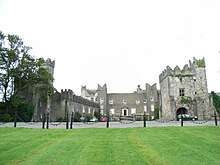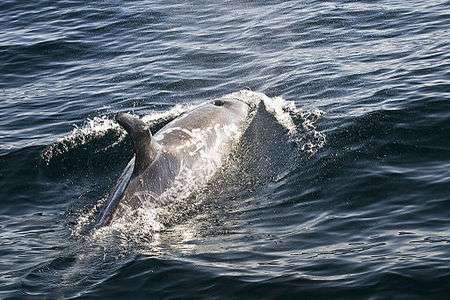Christopher St Lawrence, 2nd Baron Howth
Christopher St Lawrence, 2nd Baron Howth ( died 1462 or 1465 ) was an Anglo-Irish nobleman. He was a key figure in fifteenth-century Irish politics, and one of the strongest supporters in Ireland of the House of York, who seized the English Crown in 1461. His tomb can still be seen in the family chapel in St. Mary's Church, Howth.
Background
He was the son of Christopher (or Stephen) St Lawrence, 1st Baron Howth, and his wife Elizabeth, daughter of Sir Christopher Holywood of Artane.[1] As is often the case with Anglo-Irish titles, the precise date when the title Baron Howth was created is difficult to determine, since a "lordship" or Irish feudal barony did not necessarily imply the creation of a hereditary peerage, nor the right to sit in the Irish House of Lords. It is often said that the Crown recognised the elder Christopher as a hereditary baron around 1425, but Elrington Ball suggests that it was the younger Christopher who was recognised as the first hereditary Baron Howth in about 1461.[2]

As Lord of Howth
He succeeded to his father's estates and title in 1430, or according to some accounts in 1435, and did homage to the English Crown for his lands in 1437.[3]
He was clearly a man of strong and decided character. From the start of his career he showed a determination to assert his control over the peninsula of Howth, and to maintain all those rights and privileges which traditionally belonged to the St Lawrence family, who had been Lords of Howth since about 1177. When a twelve-foot grampus (Risso's dolphin) was stranded at Howth the Crown claimed ownership of it as a royal fish, by virtue of the royal prerogative, but Howth disputed the claim, arguing that since time immemorial every grampus and porpoise found on the peninsula of Howth was the property of the Lord of Howth.[4]
He was the patron of Richard Ingram, an early mining explorer, and at a meeting of the Privy Council in 1450 was himself granted the right to search within his lordship for lead and tin, and if any metal was found to take the profits for three years. He quarrelled with the citizens of Wicklow over the ownership of salt which he alleged they had seized unlawfully, and had them outlawed as a result; he also used his influence to have the Irish Parliament pass legislation to exempt some of his lands from taxation.[5]

In public life
Despite his determination to protect his family's hereditary rights, Howth did not neglect public affairs. He was knighted before 1442 and became a member of the Privy Council of Ireland in 1450, and from that date played a crucial part in the defence of Dublin.[6] In 1455 he was given the power to exact tolls on all those using Howth harbour to defray the costs of protecting shipping from the "French, Bretons, Scots and other nations". He was also charged with repairing the bridges at Lucan and Kilmainham. The same year he sat on a commission to inquire into the alleged failure of the Sheriff of County Dublin to adequately defend the county, and in 1458 he sat on another commission to inquire into the conduct of the Walsh family of Carrickmines Castle, whose loyalty to the Crown was suspect.[7]
Yorkist cause
When Richard, Duke of York arrived in Ireland as Lord Lieutenant in 1449, Lord Howth quickly became one of his strongest allies.[8] He returned with the Duke to England, and remained loyal to him after the setback to his fortunes which followed the Battle of Ludford Bridge in 1459. On Richard's return to Ireland later the same year, Howth was one of his key supporters in the Parliament he called. Howth was appointed to several public offices, including Constable of Dublin Castle. The legislation suggests that he was expected to accompany Richard again to England, as Richard prepared to claim the English Crown from the rival House of Lancaster, but there is no evidence that he was present at the disastrous Battle of Wakefield in December 1460, where Richard was killed.
The setback to the Yorkist cause was only temporary, and was followed by their triumph in the spring of 1461. Richard's son, the victorious King Edward IV, confirmed Howth in his office as Constable of Dublin, and recognised his right to sit in the Irish House of Lords.[9] He and his family flourished under the House of York, although later generations were to shift their allegiance to the House of Tudor, of whom they were relatives by marriage.

There is some confusion over the year of his death; his tomb indicates that he died in 1462 but some sources give his date of death as 1464 or 1465.[10]
Family
He married before 1435 Anne Plunkett of Ratoath, a relative of the 1st Baron Killeen.[11] She survived him and remarried Anthony Percy, but is buried with her first husband at Howth Castle. They had at least nine children:
- Robert St Lawrence, 3rd Baron Howth
- William, Admiral of Ireland
- Thomas
- Almeric, Clerk of the Rolls
- Lionel, precentor of St. Patrick's Cathedral, Dublin
- Walter St. Lawrence, Chief Baron of the Irish Exchequer (died 1504)
- Margaret, who married Walter Marward, titular Baron Skryne (died 1487)
- two other daughters, whose first names are unknown.
Character
Ball describes him as a man of "great qualities", who was intelligent, capable, courageous and determined.[12]
References
- Pine, L.G. The New Extinct Peerage 1884–1971 London 1972 p.150
- Ball F. Elrington History of Dublin Vol.5 1917 Dublin Alexander Thom and Co. p.49
- Ball, p.49
- Ball, p.49
- Ball, p.50
- Ball, p.50
- Ball, p.50
- Ball, p.51
- Ball p.51
- Pine, p.150
- Pine p.150
- Ball, pp.49–50